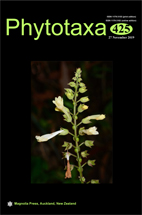Abstract
Solanum piliferum was first described by Bentham in 1840, based on material collected in the state of Oaxaca, Mexico. In 1919, the species was transferred to the genus Lycianthes by Friedrich August Georg Bitter and became the type species of his series Piliferae. This article provides a key to separate the Mexican species included by Bitter in series Piliferae, with updated species descriptions, synonymy, typification, distribution, and images of characteristics (trichomes, flowers, fruits, seeds). We address the misplacement of L. stephanocalyx and L. coffeifolia in this series and suggest limiting the series to just the species L. caeciliae, L. pilifera and L. quichensis based on habitat preferences, floral morphology, and seed characters. However, the series is not recircumscribed at this time.

